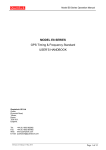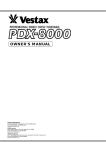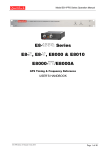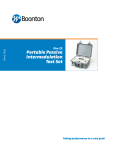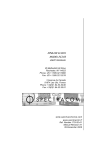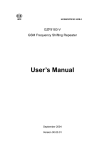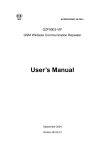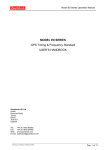Download Quartzlock A5-12 Service manual
Transcript
Model A5-32 Operation And Service Manual MODEL A5-32 32 Way Distribution Amplifier USER’S HANDBOOK Quartzlock UK Ltd Gothic, Plymouth Road, Totnes, Devon TQ9 5LH, England. Tel: Fax: Web: E-mail: +44 (0) 1803 862062 +44 (0) 1803 867962 www.quartzlock.com [email protected] A5-32 Manual 29 April 2002 Page 1 of 10 Model A5-32 Operation And Service Manual Contents Safety Considerations..........................................................................................................3 Voltage, Frequency and Power Characteristics ...................................................................4 Environmental Conditions ....................................................................................................4 Replaceable Fusing Characteristics.....................................................................................4 Cleaning Instructions ...........................................................................................................4 Distribution Amplifier A5-12 .................................................................................................5 Operating Procedure ........................................................................................................5 Circuit Descriptions ..........................................................................................................6 Output Amplifier ............................................................................................................6 Mother Board................................................................................................................6 Performance Verification ..................................................................................................7 Equipment Required .....................................................................................................7 Procedures ...................................................................................................................7 Specification.....................................................................................................................9 Appendix............................................................................................................................10 A5-32 Manual 29 April 2002 Page 2 of 10 Model A5-32 Operation And Service Manual Safety Considerations General This product and related documentation must be reviewed for familiarisation before operation. If the equipment is used in a manner not specified by the manufacturer, the protection provided by the instrument may be impaired. Before Applying Power Verify that the product is set to match the available line voltage and the correct fuse is installed. Before Cleaning Disconnect the product from operating power before cleaning. WARNING Bodily injury or death may result from failure to heed a warning. Do not proceed beyond a warning until the indicated conditions are fully understood and met. CAUTION Damage to equipment, or incorrect measurement data, may result from failure to heed a caution. Do not proceed beyond a caution until the indicated conditions are fully understood and met. This equipment must be earthed An uninterruptible safety earth ground must be maintained from the mains power source to the product’s ground circuitry. WARNING When measuring power line signals, be extremely careful and use a step down isolation transformer whose output is compatible with the input measurement capabilities of this product. The product’s front and rear panels are typically at earth ground. Thus, never try to measure AC power line signals without an isolation transformer. WARNING Instructions for adjustments when covers are removed and for servicing are for use by servicetrained personnel only. To avoid dangerous electrical shock, do not perform such adjustments or servicing unless qualified to do so. WARNING Any interruption of the protective grounding conductor (inside or outside the instrument) or disconnecting of the protective earth terminal will cause a potential shock hazard that could result in personal injury. Grounding one conductor of a two conductor out-let is not sufficient protection. Whenever it is likely that the protection has been impaired, the instrument must be made inoperative and be secured against any unintended operation. If the instrument is to be energised via an autotransformer (for voltage reduction) make sure the common terminal is connected to the earthed pole terminal (neutral) of the power source. Instructions for adjustments while the covers are removed and for servicing are for use by servicetrained personnel only. To avoid dangerous electrical shock, do not perform such adjustments or servicing unless qualified to do so. A5-32 Manual 29 April 2002 Page 3 of 10 Model A5-32 Operation And Service Manual For continued protections against fire, replace the line fuse(s) with fuses of the same current rating and type (for example, normal blow time delay). Do not use repaired fuses of short-circuited fuse holders. Voltage, Frequency and Power Characteristics Voltage 220-240V AC Frequency 40-50Hz Power characteristics 500mA Max Environmental Conditions Temperature Operating (ambient) -10°C to +55°C (-65 to +65 op) Storage -40°C to +85°C Magnetic Field Sensitivity ≤2x10-11/ Gauss Atmospheric Pressure -60m to 4000m <1x10-13/ mbar Replaceable Fusing Characteristics 800mA time-lag HBC Cleaning Instructions To ensure long and trouble operation, keep the unit free from dust and use care with liquids around the unit. Be careful not to spill liquids onto the unit. If the unit does get wet, turn the power off immediately and let the unit dry completely before turning it on again. Clean with a damp (with water) cloth. Never spray cleaner directly onto the unit or let liquid run into any part of it. Never use harsh or caustic products to clean the unit. A5-32 Manual 29 April 2002 Page 4 of 10 Model A5-32 Operation And Service Manual Distribution Amplifier A5-12 Operating Procedure Introduction The Quartzlock model A5-12 is a linear distribution amplifier designed for standard frequency distribution between 1 MHz and 100 MHz. The circuit is based on a number of balanced linear amplifiers with high reverse isolation and low phase noise. Twelve of these amplifiers are used to drive the twelve 50Ω outputs. They are called the output amplifiers in the following description. A modified version of the output amplifier with a gain control, called the input amplifier, drives a twelve way passive power splitter. This divides the signal with an insertion loss of about 12 dB, and provides isolation of about 20 dB. The output amplifiers each have an output signal monitor circuit, which is used as part of the output fail monitoring. Input One input is provided. This has input impedance of 50Ω. The input level should be between 0 and +13 dBm. Outputs Up to twelve outputs are provided. These have source impedance of 50Ω, and will provide 13 dBm nominal into a 50Ω load. Maximum output is up to 16 dBm. A5-32 Manual 29 April 2002 Page 5 of 10 Model A5-32 Operation And Service Manual Circuit Descriptions Output Amplifier The output amplifier is a differential amplifier based on a common emitter, common base, and common collector cascade circuit. TR7 and TR8 are the common emitter input stages. The emitter resistors R11 and R23, and R12 set the transconductance. A feedback circuit comprising TR4/TR5 and TR9/TR10 sets the DC collector current in each transistor. The voltage across the emitter resistors is set equal to a 2.5V reference voltage fed to the amplifier from the "BIAS" pin. The active control of DC current also reduces the current fluctuations due to 1/f noise in the transistors. This reduces the phase noise. TR2 and TR3 are the common base stages. These provide most of the reverse isolation in the amplifier. The load network, T2, R19, L1, sets the AC voltage gain of the amplifier. T2 is a wide band choke, and L1 provides high frequency compensation. The output stage of the amplifier is common collector stages TR1 and TR6. R1 and R3 set 100Ω output impedance for each transistor. When combined in T1, a 50Ω output impedance results. Due to the output impedance, the gain of the output stages is –6 dB when the amplifier is loaded with 50Ω. The voltage gain of the entire amplifier is about 12 dB, and it is capable of an output power of about 17 dBm into 50Ω. At the nominal output power of 13 dBm, the second harmonic distortion is less than -60 dBc due to the differential design. Third harmonic distortion is less than -40 dBc. The bandwidth is +/-1 dB from 2 MHz to 100 MHz. The gain falls by a further 1 dB at 1 MHz. A tuned version of the output amplifier is possible by replacing T2 by a tuned transformer T4, and by adding C21. This reduces harmonic distortion further, and also reduces integrated wide band noise. Cutting a track, enabling an isolated output option to be available on some products. The network associated with D1 rectifies a sample of the AC output and turns on TR11. This provides an output monitor point on J2. The amplifier is powered from +18V DC and +12V DC supplies. The power consumption is about 100 mA at 1 V and 40 mA at 12V. Mother Board The main board includes the input amplifier, the 12-way splitter, the power supply, and 12 output amplifier modules. The input amplifier is very similar to an output amplifier module, except variable gain is provided. The gain control is VR1, which varies the transconductance of TR6 and TR7. C12 provides high frequency compensation. The 50Ω output impedance of the input amplifier provides a good match to the passive splitter, PS1. The main board is supplied from a 24V DC supply. An off board regulator provides 18V. R41 and R42 set the voltage of the 18V supply. U3 is the 12V regulator. U1 provides the 2.5V bias supply for the input amplifier and all the output amplifiers. The output fail circuit comprises RN1, D1 to D6, and TR11. If any of the output present transistors in the output amplifiers are off, TR11 will turn on. A5-32 Manual 29 April 2002 Page 6 of 10 Model A5-32 Operation And Service Manual Performance Verification Equipment Required a) Spectrum analyser and tracking generator, 1 MHz to 100 MHz. b) Sine wave signal generator or function generator, 10 MHz c) RF Power meter d) Low pass filter, Mini-circuits BLP 10.7 e) 50Ω BNC load In addition, if input and output load and source impedance’s are to be checked, a network analyser will be required. Verification of the phase noise levels can be extremely difficult, requiring a cross correlation type of phase noise test set, with a noise floor below -150dBc at 1Hz and -160dBc at 10 Hz offset. Procedures Frequency Response Connect the tracking source to the input of the Model A5-12, and the spectrum analyser to any output. Set the tracking generator output level to 10 dBm, and the spectrum analyser to sweep between 1 MHz and 100 MHz. Adjust the A5-12 gain control (VR1) to give an output level of 13 dBm at 10 MHz. Measure the frequency response and verify against the specifications. Harmonic Distortion Connect the 10 MHz signal source to the Model A5-12 input using the low pass filter to remove source harmonics to less than -60 dBc. Set the output level to +10 dBm. Connect the spectrum analyser to any output and adjust the A5-12 gain control to give +13 dBm output. Use the spectrum analyser to measure the harmonic distortion, and verify against the specifications. Repeat for other outputs if desired. Take care that the spectrum analyser is not generating harmonics so as to affect the measurement. Output to Output Isolation Set the tracking generator to +10dBm output level, and connect to any output of the A5-12. Terminate the A5-12 input with a 50Ω load. Connect the spectrum analyser to any other output of the A5-12, and adjust for maximum sensitivity. Measure the output isolation at 10 MHz and 100 MHz. Note that it may be necessary to fit ferrite sleeves to the spectrum analyser and/or tracking generator cables to avoid common mode cross talk. The output-to-output isolation is defined as the tracking generator level minus the level measured by the spectrum analyser. Repeat for a number of combinations of outputs, choosing adjacent and remote outputs, and verify against the specifications. Output to Input Isolation Connect the tracking generator to any output, and the spectrum analyser to the input of the A5-12 and adjust for maximum sensitivity. Measure the output isolation at 10 MHz and 100 MHz. Note that it may be necessary to fit ferrite sleeves to the spectrum analyser and/or tracking generator cables to avoid common mode cross talk. The output-to-input isolation is defined as the tracking generator level minus the level measured by the spectrum analyser. Repeat for a number of combinations of outputs, choosing adjacent and remote outputs, and verify against the specifications.. A5-32 Manual 29 April 2002 Page 7 of 10 Model A5-32 Operation And Service Manual Maximum Output Connect the 10 MHz signal source to the input of the A5-12, and the spectrum analyser to any output. Increase the input level until the third harmonic rises abruptly, showing that clipping is occurring. Alternatively an oscilloscope may be used to adjust to maximum output. Transfer the output to the RF power meter and read the maximum output level. Repeat at 10 MHz if required. Spurious Outputs and Wideband Noise. With the gain of the A5-12 adjusted for 13 dBm output with 10 dBm input at 10 MHz, disconnect the signal source and terminate the input with the 50Ω load. Connect the spectrum analyser to any input and search for discrete spurii. Calculate their level in dBc related to the 13 dBm nominal output. Measure the wideband noise, using a preamplifier if necessary to improve the spectrum analysers’ noise figure, correct for measurement bandwidth, log amplifier, and detector. Alternatively use a noise figure meter. Input and Output SWR Measure using a reflection bridge or network analyser Setting Up The only user adjustment required is to set the output levels. To do this proceed as follows: 1) Remove the lid. 2) Connect desired input between 0 and 13 dBm. 3) Connect a spectrum analyser, oscilloscope with 50Ω input impedance, or RF power meter to any output. 4) Adjust output level to 13dBm (1V RMS) using the pre-set (VR1) on the main board. 5) Replace the lid. Note: All the amplifiers are class A linear amplifiers. The gain may be set to provide any output level up to clipping if desired. A5-32 Manual 29 April 2002 Page 8 of 10 Model A5-32 Operation And Service Manual Specification 1. No of outputs: 12 2. No of inputs: 1 3. Input Characteristics: a. Impedance: b. Level: c. Input SWR: 4. Output Characteristics: a. Impedance: b. Level: c. Output SWR: d. Maximum output: 5. Frequency Response: a. 2 MHz to 100 MHz b. 500 kHz to 100 MHz 50 Ω nominal 0 dBm to +13 dBm adjustable, sine wave <1.2: 1 at 10 MHz <1.5: 1 at 100MHz 50 Ω nominal 13 dBm nominal into 50 Ω (1 volt RMS) <1.2:1 16 dBm at 10 MHz typical 14 dBm at 100 MHz typical ±1.5dB ±3dB 6. Harmonics: (at nominal output, 10 MHz) (Source harmonics less than -60dBc) a. Second harmonic b. Third harmonic 7. Isolation: a. Output to output b. Output to input 8. Phase Noise: (10MHz) Offset From Carrier a. 1 Hz b. 10 Hz c. >100 Hz < -50dBc < -40dBc >90dB (adjacent outputs) at 10 MHz >70dB (adjacent outputs) at 100 MHz Typically >110 dB at 10 MHz and >90 dB at 100 MHz >110dB at 10 MHz >90 dB at 100 MHz Phase Noise, dBc -140 -150 -165 9. Spurious Outputs: < -110 dBc (above 1 MHz) (typically <-120 dBc)* 10. Broadband Noise: < -150 dBm/Hz 11. Delay Match Between Outputs < 1ns 12. Temperature Stability of Delay: 10ps/°C Phase change at output due to open or short at any other output (Calculated from isolation): <0.5ps (at 10MHz) *Spurious outputs are exclusively from the switch mode power supply A5-32 Manual 29 April 2002 Page 9 of 10 Model A5-32 Operation And Service Manual Appendix A5-32 Manual 29 April 2002 Page 10 of 10










